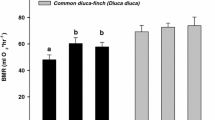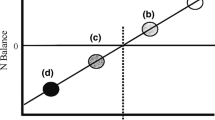Abstract
Lespedeza cuneata contains high levels of phenolics and is a common food plant of the meadow vole (Microtus pennsylvanicus);Penstemon digitalis contains substantial quantities of alkaloids and is a common food plant of meadow voles and prairie voles (M. ochrogaster). We investigated the palatability of these plants and the effects of their secondary compounds on the digestion efficiencies and growth of both species of voles. Voles ate very little of either plant when alternative food was present. Phenolics and alkaloids were extracted from the plants, incorporated into separate artificial diets, and fed to weanling voles for three weeks.Lespedeza phenolics reduced the growth of meadow voles but not prairie voles throughout the feeding trial. These compounds disrupted digestion, reducing protein digestibility by more than half.Penstemon alkaloids lowered only the initial growth rates of prairie voles and had no significant effect on meadow voles. Prairie voles tended to increase food consumption rates on bothLespedeza andPenstemon diets. This response offset some of the decrease in digested protein intake in the first case, and offset the increased metabolic cost of processing the diet in the latter case. Our results indicate that althoughLespedeza phenolics andPenstemon alkaloids do influence consumption and digestibility of artificial diets, they do not greatly reduce the performance (i.e., growth or survival) of voles when consumed at levels generally observed for wild voles. However, these compounds probably do place an upper limit on the amount of freshLespedeza andPenstemon that can be consumed and contribute to the generalist feeding strategy of voles.
Similar content being viewed by others
References
Allison, M.J. 1978. The role of ruminai microbes in the metabolism of toxic constituents from plants, pp. 101–118,in R.F. Keeler, K.R. VanKampen, and L.F. James (eds.). Effects of Poisonous Plants on Livestock. Academic Press, New York, 600 pp.
Association of Official Analytical Chemists. 1975. Official Methods of Analysis. Association of Official Analytical Chemists, Washington, D.C., 1094 pp.
Batzli, G.O., andCole, F.R. 1979. Nutritional ecology of microtine rodents: Digestibility of forage.J. Mammal. 60:740–750.
Bell, T.A., Etchells, J.L., andSmart, W.G.G., Jr. 1965. Pectinase and cellulase enzyme inhibitor from sericea and certain other plants.Bot. Gaz. 126:40–45.
Belovsky, G.E. 1978. Diet optimization in a generalist herbivore: The moose.Theor. Popul. Biol. 14:105–130.
Belovsky, G.E. 1981. A possible response of moose to sodium availability.J. Mammal. 62:631–633.
Booth, A.N., andBell, T.A. 1968. Physiological effects of sericea tannin in rats.Proc. Soc. Exp. Biol. Med. 128:800–803.
Broadhurst, R.B., andJones, W.T. 1978. Analysis of condensed tannins using acidified vanillin.J. Sci. Food Agric. 29:788–794.
Bryant, J.P., andKuropat, P.J. 1980. Selection of winter forage by subarctic browsing vertebrates: The role of plant chemistry.Annu. Rev. Ecol. Syst. 11:261–285.
Calvert, J.J. 1985. Food selection by western gorillas (C. g. gorilla) in relation to food chemistry.Oecologia 65:236–246.
Cole, F.R., andBatzli, G.O. 1979. Nutrition and population dynamics of the prairie vole,Microtus ochrogaster, in central Illinois.J. Anim. Ecol. 48:455–470.
Cooper-Driver, G., Finch, S., andSwain, T. 1977. Seasonal variation in secondary plant compounds in relation to the palatability ofPteridium aquilinwn.Biochem. Syst. Ecol. 5:177–183.
Cordell, G.A. 1981. Introduction Alkaloids. A Biogenetic Approach. John Wiley & Sons, New York, 1056 pp.
Donnelly, E.D., andAnthony, W.B. 1969. Relationship of tannin, dry matter digestibility and crude protein in sericea lespedeza.Crop Sci. 9:361–362.
Donnelly, E.D., andAnthony, W.B. 1970. Effect of genotype and tannin on dry matter digestibility in sericea lespedeza.Crop Sci. 10:200–202.
Feeny, P.P. 1976. Plant apparency and chemical defense.Recent Adv. Phytochem. 10:1–40.
Fraser, D., Chavez, E.R., andPaloheimo, J.E. 1984. Aquatic feeding by moose: Selection of plant species and feeding areas in relation to plant chemical composition and characteristics of lakes.Can. J. Zool. 62:80–87.
Grodzinski, W., andWunder, B. 1975. Ecological energetics of small mammals, pp. 173–204,in F.B. Golley, K. Petrasewicz, and L. Ryskowski (eds.). Small Mammals: Their Productivity and Population Dynamics. Cambridge University Press, Cambridge, 451 pp.
Jung, H.G., andBatzli, G.O. 1981. Nutritional ecology of microtine rodents: Effects of plant extracts on the growth of arctic microtines.J. Mammal. 62:286–292.
Kendall, W.A., andGoelz, M.F.B. 1981. Some responses of meadow voles to alkaloids in reed canarygrass. XIV International Grassland Congress, Lexington, Kentucky (summaries of papers).
Kendall, W.A., andSherwood, R.T. 1975. Palatability of leaves of tall fescue and reed canarygrass and of some of their alkaloids to meadow voles.Agron. J. 67:667–671.
Lindroth, R.L. 1984. The role of plant chemical defenses in the nutritional ecology of voles. PhD dissertation. University of Illinois, Urbana, 124 pp.
Lindroth, R.L., andBatzli, G.O. 1983. Detoxication of some naturally occurring phenolics by prairie voles: A rapid assay of glucuronidation metabolism.Biochem. Syst. Ecol. 11:405–409.
Lindroth, R.L., andBatzli, G.O. 1984a. Food habits of the meadow vole (Microtus pennsyl-vanicus) in bluegrass and prairie habitats.J. Mammal. 65:600–606.
Lindroth, R.L., andBatzli, G.O. 1984b. Plant phenolics as chemical defenses: Effects of natural phenolics on survival and growth of prairie voles (Microtus ochrogaster).J. Chem. Ecol. 10:299–244.
Lindroth, R.L., andBatzli, G.O. 1986. Inducible plant chemical defenses: A cause of vole population cycles?J. Anim. Ecol. In press.
Lindroth, R.L., Batzli, G.O., andGuntenspergen, G.R. 1984. Artificial diets for use in nutritional studies with microtine rodents.J. Mammal. 65:139–143.
Lindroth, R.L.,Batzli, G.O., andSeigler, D.S. 1986. Patterns in the phytochemistry of three prairie plants.Biochem. Syst. Ecol. In press.
McCoy, J.W., andStermitz, F.R. 1983. Alkaloids fromCastilleja miniata andPenstemon whippleanus, two host species for the plume moth,Amblyptilia (Platyptilia) pica.J. Nat. Prod. 46:902–907.
McKey, D.B., Gartlan, J.S., Waterman, P.G., andChoo, G.M. 1981. Food selection by black colobus monkeys (Columbus satanas) in relation to plant chemistry.Biol. J. Linn. Soc. 16:115–146.
Milton, K. 1979. Factors influencing leaf choice by howler monkeys: A test of some hypotheses of food selection by generalist herbivores.Am. Nat. 114:362–378.
Oates, J.F., Swain, T., andZantovska, J. 1977. Secondary compounds and food selection byColobus monkeys.Biochem. Syst. Ecol. 5:317–321.
Price, P.W., Bouton, C.E., Gross, P., Mcpheron, B.A., Thompson, J.N., andWeis, A.E. 1980. Interactions among three trophic levels: Influence of plants on interactions between insect herbivores and natural enemies.Annu. Rev. Ecol. Syst. 11:41–65.
Radwan, M.A., Crouch, G.L., Harrington, C.A., andEllis, W.D. 1982. Terpenes of ponderosa pine and feeding preferences by pocket gophers.J. Chem. Ecol. 8:241–253.
Rhoades, D.F., andGates, R.G., 1976. To ward a general theory of plant antiherbivore chemistry.Recent Adv. Phytochem. 10:168–213.
Robinson, T. 1979. The evolutionary ecology of alkaloids, pp. 413–448,In G.A. Rosenthal and D.H. Janzen (eds.). Herbivores. Their Interaction with Secondary Plant Metabolites. Academic Press, New York, 718 pp.
Roby, M.R., andStermitz, F.R. 1984. Penstemonoside and other iridoids fromCastilleja rhexifolia. Conversion of penstemonoside to the pyridine monoterpene alkaloid rhexifoline.J. Nat. Prod. 47:854–857.
Roux, D.G., Ferreira, D., andBotha, J.J. 1980. Structural considerations in predicting the utilization of tannins.J. Agric. Food Chem. 28:216–222.
Sakan, T., Murai, F., Hayashi, Y., Honda, Y., Shono, T., Nakajima, M., andKato, M. 1967. Structure and stereochemistry of boschniakine, boschnialactone, and boschnialinic acid, an oxidation product of boschnialactone.Tetrahedron 23:4635–4652.
Schwartz, C.C., Regelin, W.L., andNagy, J.G. 1980. Deer preference for juniper forage and volatile oil treated foods.J. Wildl. Manage. 44:114–120.
Shenk, J.S., Elliott, F.C., andThomas, J.W. 1970. Meadow vole nutrition studies with semisynthetic diets.J. Nutr. 100:1437–1446.
Swain, T. 1979. Tannins and lignins, pp. 657–682,in G.A. Rosenthal and D.H. Janzen (eds.). Herbivores. Their Interaction with Secondary Plant Metabolites. Academic Press, New York, 718 pp.
Swank, W.G. 1956. Protein and phosphorus content of browse plants as an influence on southwestern deer herd levels.Trans. North Am. Wildl. Conf. 21:141–158.
Swift, R.W. 1948. Deer select most nutritious forages.J. Wildl. Manage. 12:109–110.
Zucker, W.V. 1983. Tannins: does structure determine function? An ecological perspective.Am. Nat. 121:335–365.
Author information
Authors and Affiliations
Rights and permissions
About this article
Cite this article
Lindroth, R.L., Batzli, G.O. & Avildsen, S.I. Lespedeza phenolics andPenstemon alkaloids: Effects on digestion efficiencies and growth of voles. J Chem Ecol 12, 713–728 (1986). https://doi.org/10.1007/BF01012104
Received:
Accepted:
Issue Date:
DOI: https://doi.org/10.1007/BF01012104




